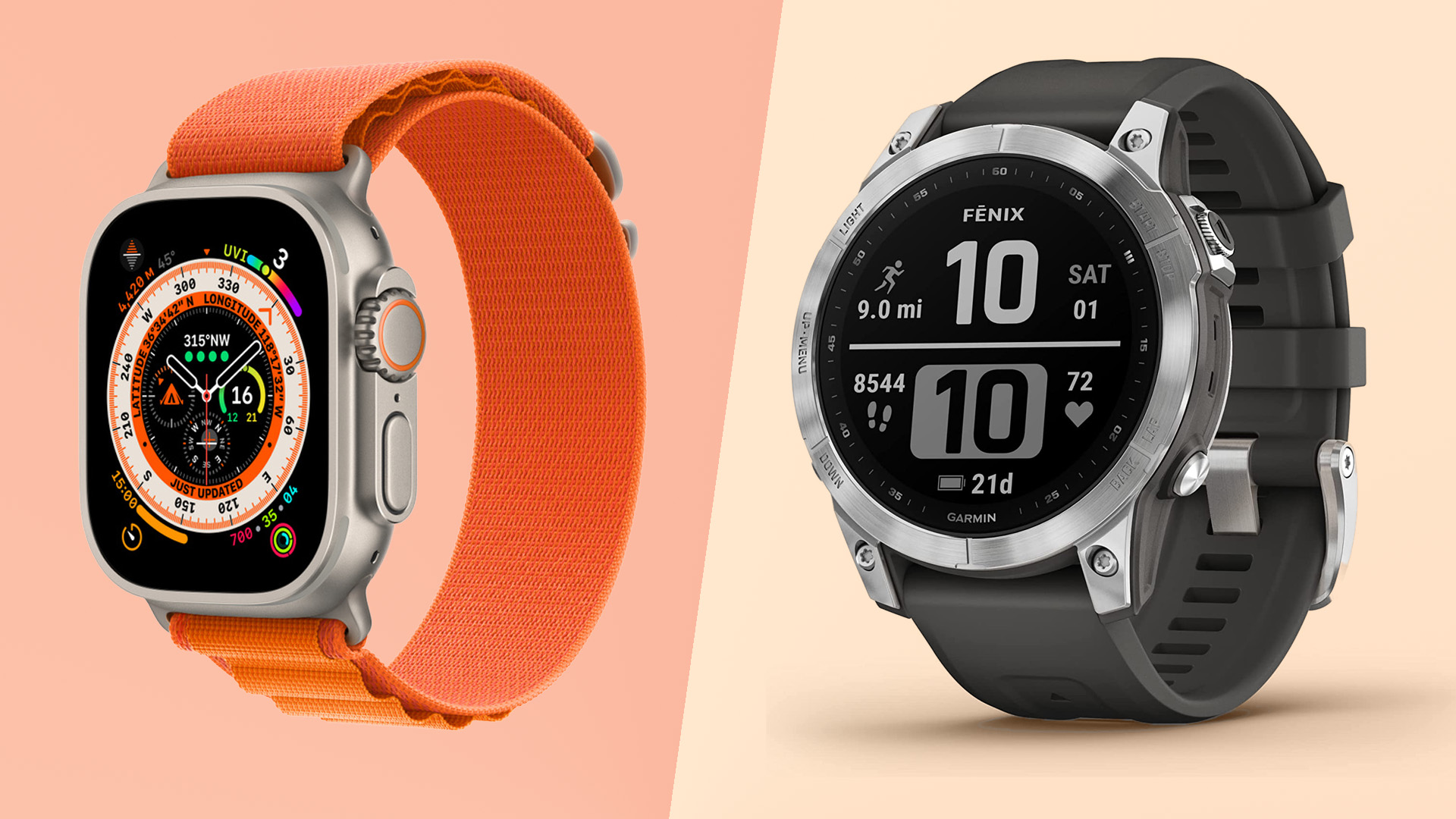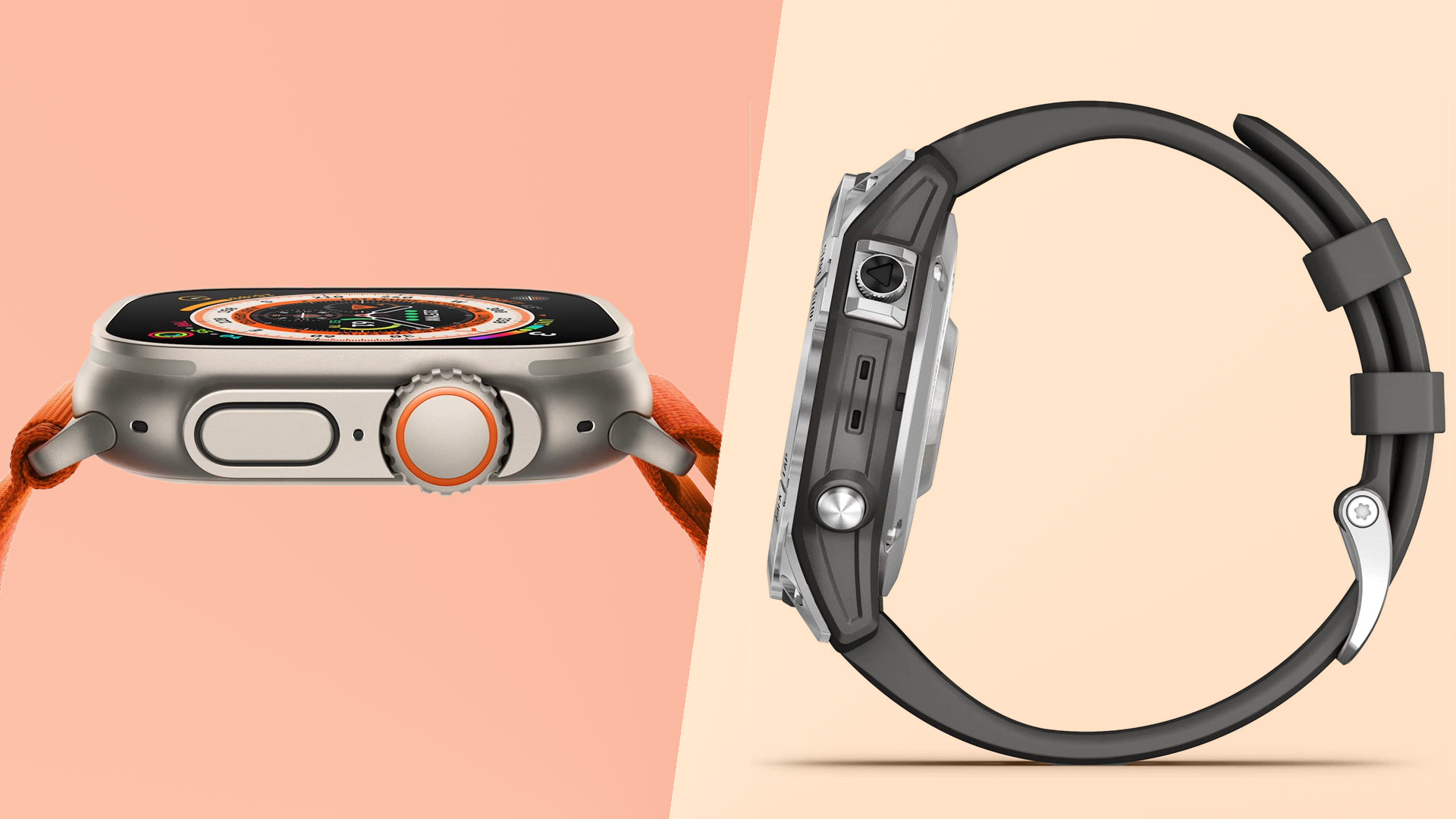Apple Watch Ultra vs Garmin Fenix 7: Which watch is right for you?

Apple has released the most significant new product in the Apple Watch line, arguably since its earliest days. It’s the Apple Watch Ultra, a tough and longer-lasting smartwatch made for adventuring types who need something a bit more rugged.
It takes aim at the audience who until now may not have been able to justify an Apple Watch over the best Garmin watch. Those are often the first choice for serious runners, hikers, and folks who want to track more niche pursuits than just running, walking, and cycling.
Does the Apple Watch Ultra actually match the best of Garmin? We are going to compare the Ultra to the Garmin Fenix 7. It’s not the priciest watch Garmin makes, but it is the high-end model we tend to recommend most often to folks. And at $699 for the standard edition and $799 for the Fenix 7 Solar, it’s fairly close to the $799 Apple Watch Ultra.
We'll compare their design, GPS tracking accuracy, battery life, smart features, and value for money in order to see how the Ultra stacks up against one of the best adventure watches around.
Apple Watch Ultra vs Garmin Fenix 7: Design
These two watches are of a similar size. The Watch Ultra is 0.1mm thinner, and their shapes are a little different. Garmin’s Fenix 7 is round, and has a diameter of 47mm. The Apple Watch Ultra is more of a rectangle, 49mm tall and 44mm wide.
One dimension counters the other, making them roughly comparable. The Apple Watch is significantly heavier, though. It weighs 61.3g without a strap. The standard stainless steel Fenix 7 weighs 56g, dropping to 50g in the titanium version.
That may be the fairest comparison, as the Watch Ultra has a titanium shell with a ceramic back. Take a closer look and the reason for the disparity becomes obvious. The Fenix 7 is only a partial metal design. Regardless of the version you get, the side walls are a plastic polymer. Rugged properties are excellent in both watches. They are each rated for 100M water resistance. But while Apple says the Watch Ultra can withstand dive depths of 40M, Garmin makes no diving claims for the Fenix 7 at all.
Sign up for breaking news, reviews, opinion, top tech deals, and more.
We don’t think the watch would suddenly fill with water at 40M. However, Garmin leaves diving properties to its Descent D1 Dive, and the super-pricey Descent MK2. Both of those are dive rated for 100M, beating the Apple Watch Ultra. Still, if you’re a diver and are only choosing between these two, the Apple Watch Ultra is the obvious pick. And not just for its depth rating. Apple’s watch has a depth gauge, a pressure sensor. The Fenix 7 does not, meaning it can’t tell how far under the surface you are.
The two watches are made for other inhospitable environments too. They are both rated for use in temperatures down to -20 degrees centigrade, while the Apple Watch Ultra has the upper hand in hot temperatures. It taps out at 55 degrees, to the Garmin’s 45 degrees.
However, we do wonder if the tech inside the Apple Watch may actually contribute to temperature build-up. It has an OLED screen able to reach an incredible 2000 nits in direct sunlight, which will cause additional heat. The Fenix 7’s MIP transflective display laps up all the sunlight it can take, with no additional power use.
Of course, in reality, the Apple Watch Ultra is likely to significantly reduce the maximum power of its display long before it reaches 55 degrees.

Apple Watch Ultra vs Garmin Fenix 7: GPS tracking
The Apple Watch Ultra introduces multi-band GPS, using the L1 and L5 bands. Garmin started using this tech in 2020 in its standalone GPS receivers and, yep, it’s available in the Fenix 7 too.
Both location systems also support the most important satellite arrays. These are GPS (US), GLONASS (Russia), GALILEO (EU), QZSS (Japan) and BeiDou (China).
Garmin doesn’t actually list most of these in the Fenix 7’s feature table, but they are accessible using the watch’s “all systems” mode. The watch even adds another array the Apple Watch Ultra doesn’t support, India’s IRNSS.
It is one of the smaller arrays, and probably shouldn’t sway your decision too much.
We haven’t tested the Apple Watch Ultra’s GPS system in action yet, but past experience suggests we’ll see a slightly different style of tracking to Garmin’s. Apple tends to snap to roads and paths more than Garmin, which leads to better-looking (if not necessarily more accurate) route maps.
Apple Watch Ultra vs Garmin Fenix 7: Battery life
The Apple Watch Ultra has double the battery life of the Apple Watch Series 8, 36 hours instead of 18. And there’s a power-saving mode coming soon that cuts back certain features to increase this to 60 hours.
Apple also says it will last up to 12 hours of outdoors GPS use, in the standard power mode.
None of this gets remotely close to the stamina of the Garmin Fenix 7. It can last up to 57 hours of GPS tracking, 18 days in its standard mode or 57 days in its battery save mode. That’s 432 hours to 36, 1368 hours to 60 using power saving modes.
These can also be topped up noticeably through sunlight in the solar-charging Fenix 7 models, if you get out in direct sunlight for several hours each day.
We do find that Garmin’s estimates can be a little more optimistic than Apple’s, which tend to be rock-solid. But, well, there’s no contest there.
There’s one thing can can truly kill a Fenix 7 battery: music playback. It’s only rated for 10 hours of GPS tracking with music. And given the Apple Watch Ultra can last for 20 hours of music, it could even outlast a Fenix 7 when playing music during tracked exercise.
This is a hint at the reason for the big stamina disparity. The Apple Watch Ultra is a real smartwatch with a fairly powerful processor. Garmin’s Fenix 7 has some smartwatch characteristics, but is fundamentally a much more focused fitness watch. It has a much lower-power display, and isn’t an “always connected” watch to the same extent as an Apple Watch.
It’s why we find Garmin watches so easy to get on with, though. You only have to charge them every now and then.

Apple Watch Ultra vs Garmin Fenix 7: Smart features
The Apple Watch Ultra has similar smarts to the Apple Watch Series 8. You get access to the best smartwatch app store of them all, you can make calls with your watch. And as all Ultra watches have 4G cellular, you don’t even need a phone nearby to do so.
Apple demonstrated the power of the Apple Watch platform at the launch itself, showing off a third-party app that turns the watch into a dive computer.
You can, of course, also talk to Siri through the watch as it has a triple microphone array and dual speakers. This setup can also be used to send messages, using your voice rather than a virtual keyboard.
The Watch Ultra also has an ECG heart health sensor and a temperature sensor, which can estimate the time of ovulation in a person’s menses cycle after the fact.
The Garmin Fenix 7’s classic smartwatch features are largely limited to receiving notifications from your phone, and downloading relatively basic apps from the Garmin Connect store.
However, the Fenix 7 does have a bunch of smart features that don’t rely on internet access. It can control Garmin Varia bike lights. You can connect to a bike turbo trainer and use the watch to control its resistance, and send custom ride data to it without the need for standalone platforms like TrainerRoad or Zwift.
A Fenix 7 lets you wirelessly connect other fitness accessories like footpods and heart rate straps over Bluetooth or ANT+. You can download massive map files that cover entire continents, and work out routes from point A to point B without needing a phone or internet connection.
These are not traditional smartwatch features, but they are pretty “smart” if you ask us.
Apple Watch Ultra vs Garmin Fenix 7: Value for money
The question of value relies a little on where you live, and whether we use the standard Fenix 7 as the baseline, or the pricier titanium version.
For example, in the UK the base Fenix 7 is a lot cheaper than the Ultra. It’s £599, to the £849 of the Apple Watch Ultra. However, in the US they seem much closer. The Fenix 7 costs $699, the Watch Ultra $799.
Upgrade to the titanium Fenix 7, which also has a Sapphire display and solar charging, and the Apple Watch Ultra is cheaper in the US. The fancy Fenix is $899/£779. In Australia, it's also much closer, at AU$1,199.00 for the Fenix 7 and AU$1,299 for the Apple Watch.
In the UK at least the Garmin Fenix 7 seems perhaps better value, but in the US the answer is much less clear. This difference is likely, in part, down to the weakening of the pound (and Euro) against the dollar throughout 2022.
If you’re a diver, though, the Apple Watch Ultra is clearly the better buy. It’s also cheaper than Garmin’s high-end Descent Mk2 watches — although Garmin still has the edge at the very top end. The Descent MK2i has air integration and SubWave Sonar, which may be essential if you want a pro-grade dive watch. This is potentially life-saving stuff, as it lets you see the air level of other divers in your group.
Early Verdict
The Apple Watch Ultra is an interesting watch with some impressive characteristics. Apple hasn’t simply amped up the display and battery life. It also added dive-ready water resistance and a depth sensor, making it a viable tracker for hobbyist scuba divers.
Under the water, it is more capable than the Garmin Fenix 7. Out of the water, the Fenix may hold up better for many people thanks to its ultra-long battery life, and that bright outdoors conditions aren’t going to impact battery life, unlike the Watch Ultra’s 2000-nit OLED display.
Apple has successfully chipped away at the argument serious oudoorsy types need a Garmin rather than an Apple Watch. However, we can’t help but feel, to use Apple’s own use case example, that if you’re a dive leader rather than someone who does it as a hobby, you’d probably still prefer a pro-level device like the Garmin Descent MK2i.

Andrew is a freelance journalist and has been writing and editing for some of the UK's top tech and lifestyle publications including TrustedReviews, Stuff, T3, TechRadar, Lifehacker and others.